Ijraset Journal For Research in Applied Science and Engineering Technology
- Home / Ijraset
- On This Page
- Abstract
- Introduction
- Conclusion
- References
- Copyright
Multipurpose Sieving Machine
Authors: Aniket A. Chavan, Prathamesh D. Kadam, Sahil S. Lad, Manas M. Mankar, Sajid Shaikh
DOI Link: https://doi.org/10.22214/ijraset.2022.41087
Certificate: View Certificate
Abstract
A sieve is a device for separating wanted elements from unwanted material or for characterizing the particle size distribution of a sample, typically using a woven screen such as a mesh or net. This project focuses in design, fabrication of the mechanical part of machine and the system of the sieve machine. To achieve this project objective, this sieve machine body structure and mechanical system needs to concern some other criteria such as strength, safety and ergonomic design. Depending on their size the individual particles either pass through the sieve mesh or retained on the sieve surface. There are different machines that are being used for sand sieving processes. In our project the process will takes place automatically. Thus, the time consumed during the whole process is reduced.
Introduction
I. INTRODUCTION
Today’s world requires speed in each and every field. Hence rapidness and quick working is most important. Now a day for achieving rapidness, various machines and the equipment are being manufactured. In such a modern era of liberalization, small scale industries are contributing in a big way to the growth of our country. New machines and techniques are being developed continuously to manufacture various products at cheaper rates and high quality. This project focuses in design, fabrication of the mechanical part of machine and the system of the sieving machine. Sieving Machine mainly depends on converting rotary motion provided by AC motor. With the help of pulley attached to motor the Rotary Motion is converted into Reciprocating Motion with help of Connecting Rod and Wheels. The horizontal sieving machine is worked on the basis of crank and slider mechanism. The sieving box is placed inside the rail track and the machine is started. When the sieving box moves in the reciprocating motion the sieving process is performed. Sieving is an uncomplicated practice for sorting out the particles of different sizes. Generally, while preparing the concrete for construction purpose, the process of sieving is carried out manually. Sieving of sand is carried out using rectangular mesh which is inclined at certain angle. In the present sand sieving method, the sample is subjected to horizontal movement in accordance with the chosen method. This causes a relative motion between the particles and the sieve. Depending on their size the individual particles either pass through the sieve mesh or retained on the sieve surface. There are different machines that are being used for sand Sieving, but we demonstrate the design & fabrication of automatically driven sand sieving machine which have low cost and simple in operation. For small scale farming in rural areas the main aim of the cultivator is over domestic use. The harvest is usually a small bulk. Therefore, they are not taken in for refining in major refining factories. Here we generate an idea to solve the problem of filtering or refining the harvested crops mainly grains, cardamom etc. This project is a domestic sieving machine which can be used to separate or sieve or filter out dirt and unwanted particles from the harvested crops. The machine is compatible and requires only a limited amount of space. The machine can also sort out stones and other unwanted particles from purchased goods or stored crops.
II. LITERATURE REVIEW
A. Design and Fabrication of Domestic Sieving Machine
Alan Biju, Alwin Thomas, Akash J Kalarickal, Jeswin Jose, Rittin Abraham Kurien,
Conventional practices like winnowing require highly expertise hand movements considering gravity, aerodynamics and centrifugal force. This is the major difficulty observed in the winnowing process. Nowadays people always prefer the most suitable way to save time and energy. This project proposes a domestic sieving machine which can easily remove unwanted particles from the grains, nuts and other pulses automatically.
B. Automatically Driven Sand Sieving Machine
P.R. Gajbhiye ,RupeshKhode PratikSukhadeve ,VickyChaple
Construction of buildings requires sand as an important ingredient Sand is used at different stages in construction right from the foundation to the finishing work i.e. plaster. This sand is needs to be screened properly for various stages in construction, i.e. size of sand for construction work is slightly coarse whereas that used for plaster work is fine These processes are carried out manually. Sieving of sand is carried out using rectangular mesh which is inclined at certain angle. This causes a relative motion between the particles and the sieve. Depending on their size the individual particles either pass through the sieve mesh or retained on the sieve surface
C. Development of NCAM Reciprocating Cassava Mash Shifter
Abiodun L.O., Oladipo N.O and Bamidele B.L.
The NCAM cassava mash sifter was developed to tackle the problems of high labor, expense associated with manual sifting, time wastage, the tedious mature of the operation, injury to the hand or palm as one rubs against the raffia sieve continuously, back ache, caused by prolonged sitting in one position during manual sifting, low productivity, and the hygienically unsafe nature of manual sifting as products are exposed to germs.
D. Stacked Siever for Natural Sand Processing
W.D. Handoko, N. Widiastuti, G.S. Budi, K. Karelius, S. Pratapa
This stacked sand sieve was intended to replace conventional sieves that had several disadvantages, including unstable speed, inefficient time in processing large amounts of sand, and relatively higher costs incurred. This stacked sieve exhibited the following characters: 1) composed of two sieves, 2) can be assembled easily to change the size of the sieve, 3) had 3 variations of the sieve slope, and 4) used a gasoline motor to pro- duce a sift speed of 25.2 cm/s and 36.4 cm/s. The sieve slopes were manually adjusted by positioning the sieves according to the available slots on the device.
E. Energy-based Indicators of Soil Structure by Automatic Dry Sieving
Dmitry Fomin, Maria Timofeeva, Olga Ovchinnikova, Ilya Valdes-Korovkin, Andrey Holub, Anna Yudina
Numerous methodological approaches and fractionation procedures contribute to the continuation of discussions about soil aggregate formation. This study aims to justify the dry sieving procedure and suggest an optimal sieving regime for automatic shakers for soil samples.
For this approach to calculating total sieving energy, using oscillation frequency, vibration amplitude, and time was proposed. Retisol, Phaeozem, and Chernozem topsoil samples from agricultural and native ecosystems were analyzed using a sieving test, in which 50-kg soil samples were divided into 500–700 g subsamples and sieved with a constant oscillation frequency (50 Hz), but with varying vibrational amplitudes (0–2.5 mm), for sieving times that ranged from 1 to 5 min. We found that the optimal sieving regime is characterized by total sieving energy of 1850 J kg− 1, reached during 2 min of sieving with a 50 Hz frequency and a 2.5 mm amplitude. Based on results of the dry sieving test, we have proposed the indicators of mechanical stability of soil structure: index of soil structure stability (SS) which characterize the degree of change in the soil aggregates size during sieving with minimal and optimal sieving energy, and modified the soil friability index (F4), that characterizes the rate of change in the soil aggregates size under mechanical load by dry sieving.
The proposed formula of total sieving energy calculation allows comparing results between soil studies. Our meta-analysis showed that most (26 of 34) studies used insufficient sieving energy, where the aggregate size distribution did not reach the equilibrium state. A detailed protocol for soil dry sieving analysis is provided.
F. Quality attributes of parboiled rice prepared with a parboiling process using a rotating sieve system
Naruebodee Srisang, Thatchapol Chungcharoen
The aim of this study is to apply a rotating sieve system to the parboiling process for parboiled rice production. The parboiling time and rotation speed were the main production factors affecting the quality attributes of the parboiled rice, including the degree of starch gelatinization (DG), fissure percentage, head rice yield (HRY), white belly, and color. The results showed that the parboiling process with a rotating sieve can decrease the parboiling time required to provide an even quality of parboiled rice. The parboiling time for an even quality of parboiled rice was 5 min at rotation speeds of 10 and 15 rpm, while the parboiling time at a rotation speed of 5 rpm was 10 min. These times were shorter than that with a fixed sieve (15 min). Moreover, the parboiling process using a rotating sieve system provided better qualities of parboiled rice than that using the fixed sieve system, including higher DG and HRY and lower fissure and whiteness percentages. Additionally, the values of DG and HRY were increased with increasing parboiling time. In contrast, the fissure and whiteness percentages of the parboiled rice decreased. However, the quality of the parboiled rice was not dependent on the rotation speed.
G. Shredding and sieving thermoplastic composite scrap: Method development and analyses of the fibre length distributions
Guillaume A. Vincent, Thomas A. de Bruijn, Sebastiaan Wijskamp, Mohammed Iqbal Abdul Rasheed, Martin van Drongelen , Remko Akkerman
Recycling of thermoplastic composites has attracted considerable attention in the recent years. Several recycling solutions include shredding scrap to centimetre-sized flakes to retain long fibres, followed by a remanufacturing step that prevents fibre breakage. Determining the exact fibre length distribution (FLD) for these routes is crucial, as it is of importance for the processibility of the material as well as the mechanical performance of the recycled parts. In this paper, novel analysis methods are introduced to calculate FLDs based on photographs of flakes. The reliability of the method and of the sampling was found to be high. The relation between flake size and FLD was studied, showing that offcut layup barely influences the FLD in comparison to flake size. The effects of shredding settings and sieving were studied, showing a strong correlation between machine parameters and FLD, whereas the offcut size was found to have no effect on FLD.
H. Intelligent optimal sieving method for FACTS device control in multi-machine systems
Qiang Lu, Wencong Wang, Chen Shen, Shengwei Mei, Masuo Goto, Akihiko Yokoyama
A multi-target oriented optimal control strategy for FACTS devices installed in multi-machine power systems is presented in this paper, which is named the intelligent optimal sieving control (IOSC) method. This new method divides the FACTS device output region into several parts and selects one typical value from each part, which is called output candidate. Then, an intelligent optimal sieve is constructed, which predicts the impacts of each output candidate on a power system and sieves out an optimal output from all of the candidates. The artificial neural network technologies and fuzzy methods are applied to build the intelligent sieve. Finally, the real control signal of FACTS devices is calculated according to the selected optimal output through inverse system method. Simulation has been done on a three-machine power system and the results show that the proposed IOSC controller can effectively attenuate system oscillations and enhance the power system transient stability.
III. PROBLEM STATEMENT
A. Sieving of sand particles in construction, grain sorting in agriculture is done manually and human effort is required.
B. After careful review of literature, it was found that no specific solution to separate different sizes of grains are not available.
C. The Speed of Motor cannot be controlled so that can be set according to preference.
D. The waste which is not sorted in sieving remains in sieve after an operation it needs to manually cleaned and remove.
E. Now days people always prefer the most suitable way to cut their cost and time. Example in a construction where they have to finish the work before the due date. His might be a problem. Since we have waiting long waiting for the good to arrive
F. However, sometime in big company there are high tech machine that can do this work sieving any sub stand or mixture. But sometime in construction required a special sieve machine that are comfortable and easy to use.
G. Traditional method gives low efficiency as it is operated manually but the automated sand sieving machine have higher efficiency
H. Traditional method requires more labour.
I. Traditional method is more time consumed during the process of preparing the concrete.
J. The cost of highly sophisticated machine is very high which is not affordable for small scale foundries and low-level contractors.
IV. DESIGN CONSIDERATION
A. This project focuses in design, fabrication of the mechanical part of machine and the system of the sieve machine. To achieve this project objective, this sieve machine body structure and mechanical system needs to concern some other criteria such as strength, safety and ergonomic design.
B. Sieving is done automatically of sand particles in construction, grain sorting in agriculture and various operations were things need to be sieved
C. As it is multipurpose so the sieve can be replaced as per the sieve size requirement in sieve bracket
D. As the sieve operates on reciprocating motion the speed of the motor can be controlled by foot.
E. Design and Fabricate a Sieving Machine which can filter 2-3 kg of grains at a time.
F. Selection of gathering of component for the craving moment. Components like motor, pulleys, bearing etc.
G. Calculation of vitality machine parts. Calculation of motor rpm, load of motor, torque of motor, voltage required to run motor, pulleys dimensions, bearings dimensions etc.
H. And at last manufacturing or collecting and assembling machine.
V. RESEARCH AND METHODOLOGY
Although designs vary, the method followed for Project is:
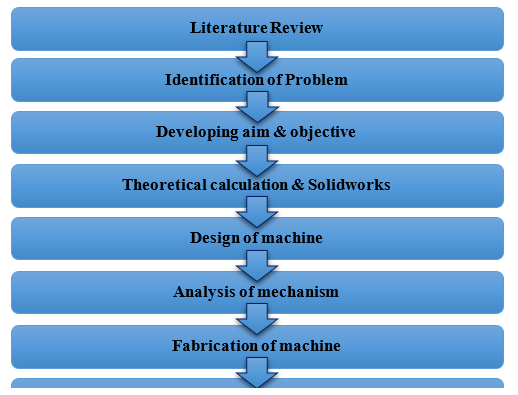
VI. WORING PRINCIPLE
The Multipurpose Sieving Machine is very easy to construct and can be operated easily. It is very economic among this kind of machines. This project is fabricated with the help of parts like a motor, crank and slider link mechanism, bearing, C.I. wheels, sieving box. The horizontal sieving machine is worked on the basis of crank and slider mechanism. Here crank is attached to the sieve box the power is given by motor through pulley belt arrangement. The rail bracket is made in which the sieving box moves in it. The sieving box fixed with the connecting rod in order to move when the wheel is rotated by means of pulley attached to the motor. The sieving box is placed inside the rail bracket and the machine is started. When the sieving box moves in the reciprocating motion the sieving process is performed for various operations by changing the inner sieve for different applications.
VII. CAD MODEL
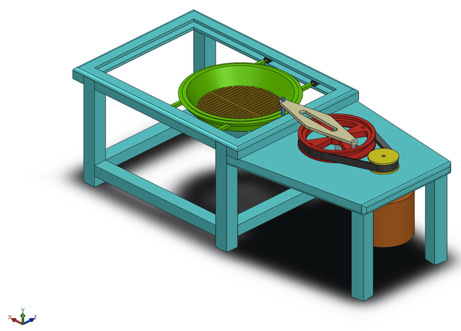
VIII. COMPONENTS
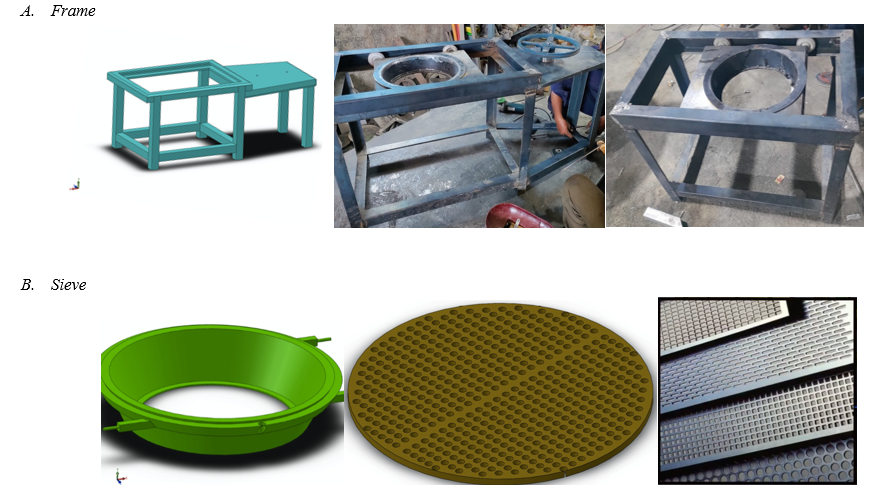
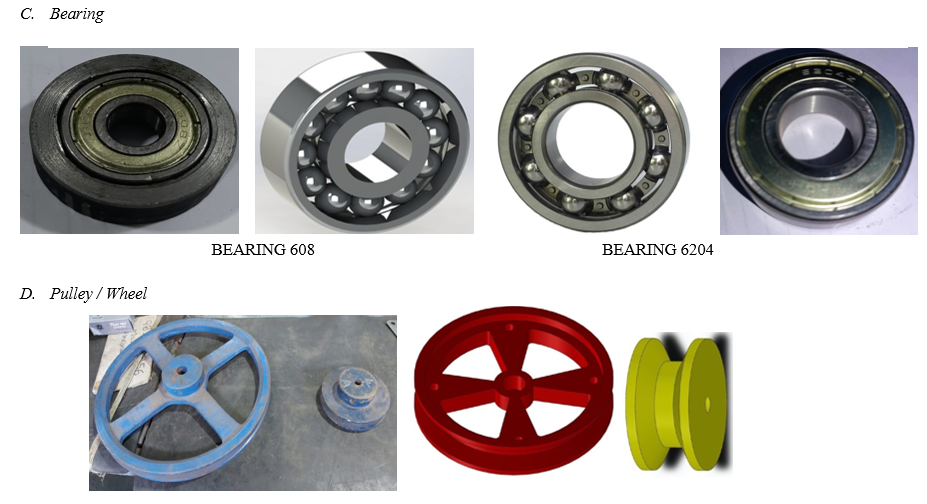
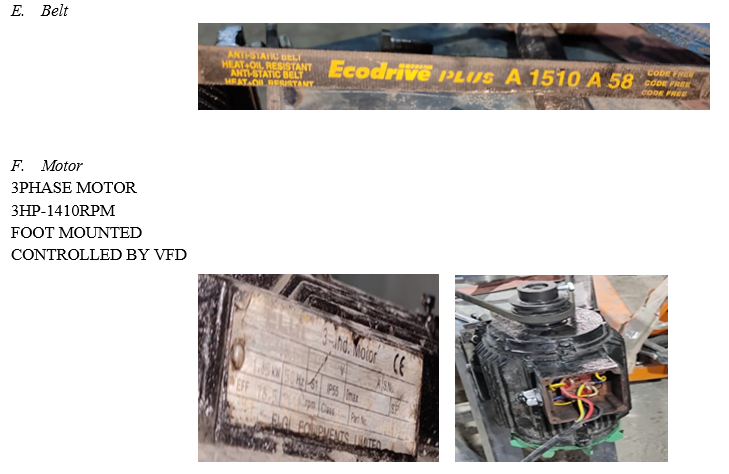
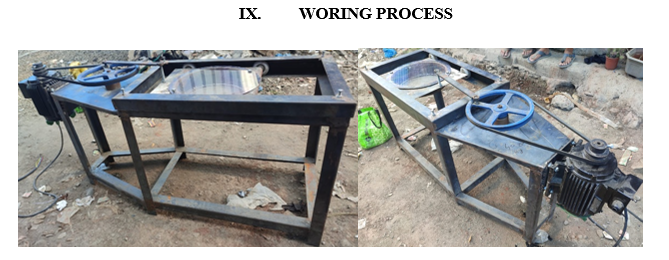
X. SCOPE FOR FUTURE WORK
The project can be made for higher capacities by increasing the dimension and improving the design aspects. The machine can be operated using solar energy also which is economically useful.
Conclusion
In this research study, the mild steel failure problems encountered by loads were successfully. Thus, a cost effective and simple design motor operated multipurpose sieving machine is fabricated. This machine reduces the human effort and hence we don’t need multiple persons to filter/sieve at a time. Also, machine is portable as it can be de-assembled and assembled easily.
References
[1] Alan Biju, Alwin Thomas, Akash J Kalarickal, Jeswin Jose, Rittin. Abraham Kurien, Assistant Professor, Department of Mechanical Engineering, Saintgits College of Engineering, Kottayam, Kerala, India “Design and Fabrication of Domestic Sieving Machine” (2020 IJRAR May 2020, Volume 7, Issue 2) [2] RupeshKhode PratikSukhadeve ,VickyChaple, P.R.Gajbhiye ,Assistant professor, Department Of Mechanical Engineering, K. D. K. College Of Engineering, Nagpur-440009, Maharashtra, India. “Design and Fabrication of Automatically Driven Sand Sieving Machine” (2019 JEITR, Volume 6, Issue 5) [3] Abiodun L.O., Oladipo N.O and Bamidele B.L. National Centre for Agricultural Mechanization, Ilorin, Kwara State, Nigeria. “Development of NCAM Reciprocating Cassava Mash Sifter.” (Vol. 5 No. 1. 2016. Pp. 10-13) [4] W.D. Handoko , N. Widiastuti , G.S. Budi, K. Karelius, S. Pratapa, Departement of Physics, Faculty of Sciences and Data Analytics, Institut Teknologi Sepuluh Nopember, Surabaya 60111, Indonesia, Departement of Chemistry, Faculty of Sciences and Data Analytics, Institut Teknologi Sepuluh Nopember, Surabaya 60111, Indonesia, Departement of Physics Education, Faculty of Teacher Training and Education, University of Palangka Raya, Palangka Raya 74874, Indonesia, Departement of Chemistry, Faculty of Mathematics and Natural Sciences, University of Palangka Raya, Palangka Raya 74874, Indonesia “ Design and characterization of a stacked siever for natural sand processing” (2021 Elviser proceedings 44 3237-3240) [5] Dmitry Fomin, Maria Timofeeva, Olga Ovchinnikova, Ilya Valdes-Korovkin, Andrey Holub, Anna Yudina, Soil Science Institute, Pyzhyovskiy Lane 7 Building 2, 119017, Moscow, Russia, Institute of Mechanics, Lomonosov Moscow State University, Michurinsky Prosp. 1, 119192, Moscow, Russia “Energy-based indicators of soil structure by automatic dry sieving” (2021 Soil & Tillage Research 214) 105183) [6] Naruebodee Srisang, Thatchapol Chungcharoen, Department of Engineering, King Mongkut\'s Institute of Technology Ladkrabang, Prince of Chumphon Campus, Chumphon, 17/1 Moo. 6 Chumkho, Pathio, Chumphon, 86160, Thailand. “Quality attributes of parboiled rice prepared with a parboiling process using a rotating sieve system” (2019 Journal of Cereal Science 286-294) [7] Guillaume A. Vincent, Thomas A. de Bruijn, Sebastiaan Wijskamp, Mohammed Iqbal Abdul Rasheed, Martin van Drongelen , Remko Akkerman, Group of Production Technology, University of Twente, 7522 NB Enschede, the Netherlands. ThermoPlastic composites Research Center, Palatijn 15, 7521 PN Enschede, the Netherlands. ThermoPlastic composites Application Center, Saxion University of Applied Sciences, M.H. Tromplaan 28, 7513 AB Enschede, the Netherlands “Shredding and sieving thermoplastic composite scrap: Method development and analyses of the fibre length distributions” (2019 Composites Part B 176 107197) [8] Qiang Lu, Wencong Wang, Chen Shen, Shengwei Mei, Masuo Goto , Akihiko Yokoyama, Department of Electrical Engineering, Tsinghua University, Beijing 100084, China. Power Systems Division, Hitachi Ltd, Tokyo, Japan. Department of Electrical Engineering, School of Engineering, Tokyo University, Tokyo, Japan “Intelligent optimal sieving method for FACTS device control in multi-machine systems” (2002 Electric Power System Research 62 209-214)
Copyright
Copyright © 2022 Aniket A. Chavan, Prathamesh D. Kadam, Sahil S. Lad, Manas M. Mankar, Sajid Shaikh. This is an open access article distributed under the Creative Commons Attribution License, which permits unrestricted use, distribution, and reproduction in any medium, provided the original work is properly cited.

Download Paper
Paper Id : IJRASET41087
Publish Date : 2022-03-29
ISSN : 2321-9653
Publisher Name : IJRASET
DOI Link : Click Here
 Submit Paper Online
Submit Paper Online

